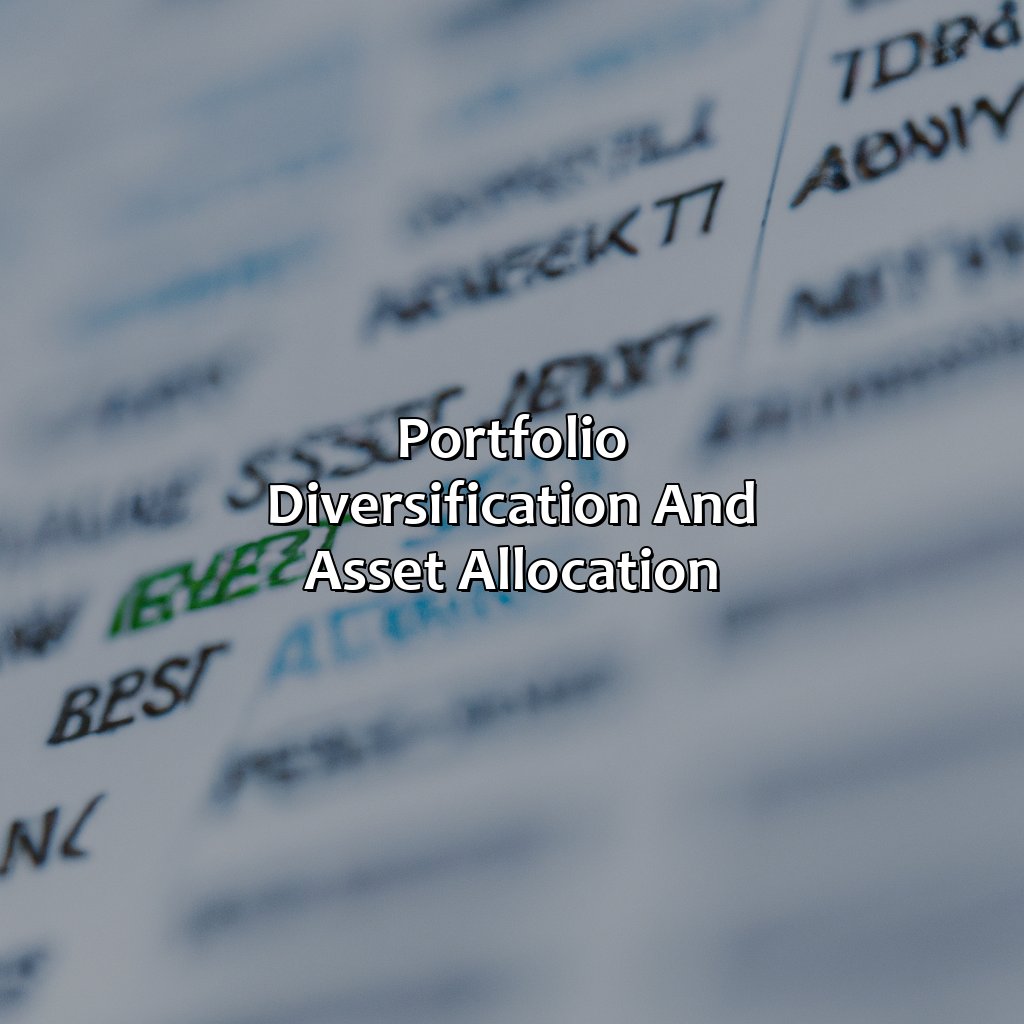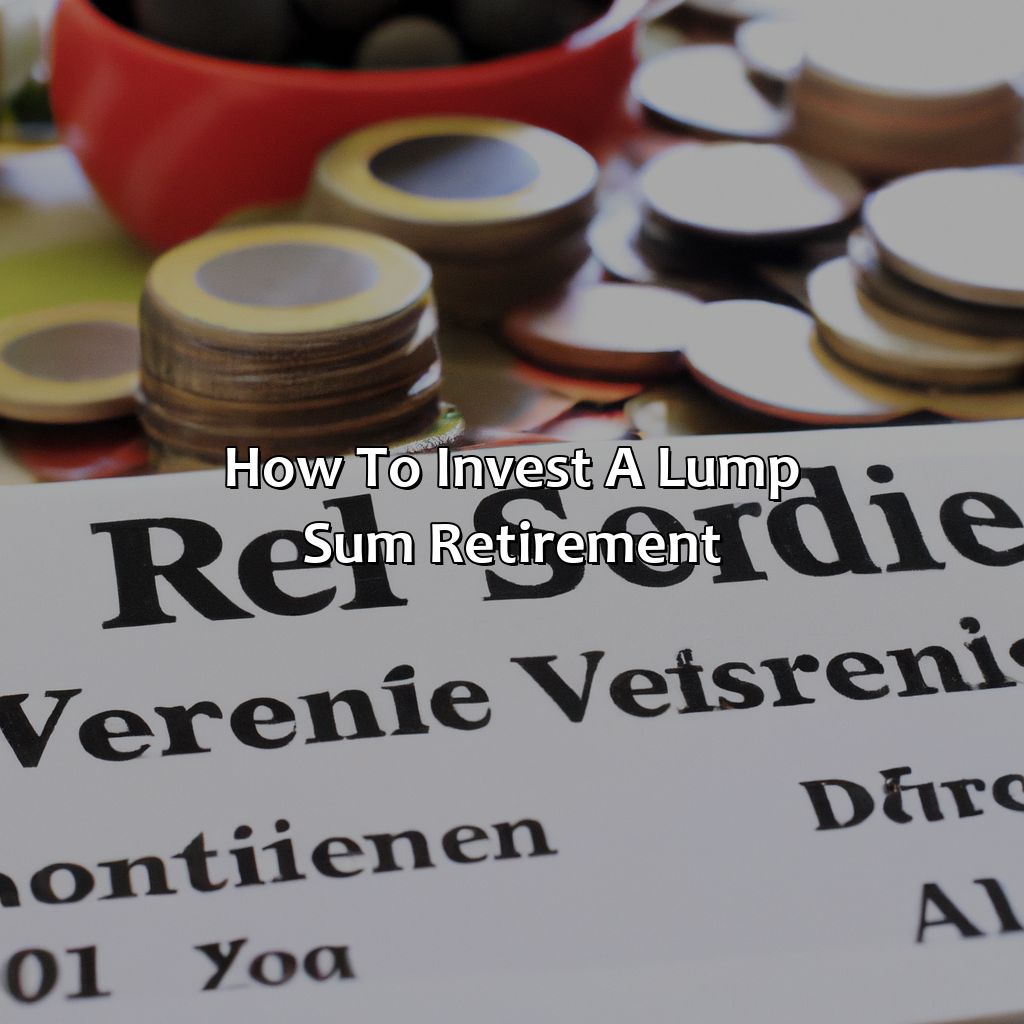How To Invest A Lump Sum Retirement?
Key takeaway:
- Consider health and life expectancy, financial goals and income needs, and risk tolerance when investing a lump sum retirement.
- Investment options for a lump sum retirement include mutual funds, exchange-traded funds (ETFs), and annuities. Diversification and portfolio allocation are important factors to consider.
- Working with a financial advisor can provide valuable guidance and expertise in managing a lump sum retirement and achieving financial goals.
You ready to give yourself a jumpstart to your retirement? Investing your lump sum retirement funds is the key to financial freedom and security. With the right guidance, you’ll find out how to make the most of your savings.
Factors to consider before investing a lump sum retirement
Your retirement lump sum needs consideration. Before investing, three key factors should be kept in mind. Those are: health & life expectancy, financial goals & income needs and risk tolerance. These will guide you to determine the best path for your situation.

Image credits: retiregenz.com by James Woodhock
Health and life expectancy
Investors should carefully evaluate their health and life expectancy before investing a lump sum for retirement. Understanding one’s physical and mental well-being is crucial in determining the amount of money required to sustain life after retirement. With advances in healthcare, people are living longer than ever before, making it imperative to consider longevity risk while choosing investments. It is recommended to create a financial plan that caters to long-term medical expenses and contingencies.
Planning for a comfortable retirement requires taking into account several factors, with one’s health being a significant consideration. Longer lifespan means more money will be required to sustain oneself without an income source post-retirement. Therefore, generating returns from high yield products may lead to exhaustion of funds over time, resulting in financial distress later in life. Evaluating one’s health condition along with expected longevity provides greater insight into what types of investments will provide long term sustainability.
Additionally, considering critical illness policies or long-term care insurance plans can mitigate unforeseen medical expenditures to preserve investment capital. Building up an emergency fund can also help cover unforeseen contingencies or gap periods between retirement and receiving government pension, such as sudden job loss or changes in personal circumstances. By establishing such safety nets early on investors equip themselves better for any unforeseeable events down the line.
Investing intelligently based on one’s unique situation, goals and finances could protect against outliving one’s assets while ensuring financial flexibility during the course of retirement. Thus it is vital to consider all aspects of financial planning while creating a realistic budget for post-retirement life.
Retirement goals: spending all your time on the golf course and not worrying about money. Life goals: hitting a hole-in-one and not having to fish your ball out of a pond.
Financial goals and income needs
When investing a lump sum for retirement, it is crucial to consider your financial goals and income needs. Your financial goals should align with your investment strategy to maximize the likelihood of achieving them. Assessing your income needs will help you determine how much you will need to withdraw from your investments annually to sustain your lifestyle during retirement.
In addition to these factors, it is essential to consider the risk tolerance that you possess. Investing in high-risk stocks may yield higher returns, but if you cannot handle market fluctuations, this may not be the best option for you. Furthermore, diversification is essential in minimizing risk and maximizing returns.
Pro Tip: Consult with a licensed financial advisor who can tailor a plan specific to your circumstances and goals. Investing your retirement savings is like playing Russian roulette, except the stakes are higher and the bullets are labeled ‘market volatility’.
Risk tolerance
Investors’ capacity to take risks is a crucial factor in determining how to invest a lump sum retirement. An investor’s risk tolerance defines their ability and willingness to withstand losses or volatile market conditions. Simply put, it is the amount of uncertainty that investors can bear while investing their money.
It is vital to determine your risk tolerance before choosing investment options for your retirement fund. A high-risk strategy may yield a potential high return, but it comes with increased levels of volatility and level of risk. Conversely, low-risk investments may offer more stable returns, but they tend to have more shallow returns over time.
Factors such as age, income level and financial goals influence an investor’s readiness for risk-taking behaviour in investment decisions. The rule of thumb suggests that young investors should opt for higher-risk assets as they have more time to recover from any potential losses.
Remember that limitations in the performance of the markets can reduce investment value despite the available strategies’ discipline and proven track record. Diversification can help eliminate some concentrated risks and promote sustainable growth opportunities.
Pro Tip: Investors can use Monte Carlo simulation tools to assess their portfolio’s potential outcomes under different scenarios before making any substantial investment decisions.
You’ve got options, just make sure your retirement fund doesn’t end up in a black hole.
Investment options for a lump sum retirement
Investment possibilities for your retirement lump sum? Look at mutual funds, ETFs, and annuities. Each has distinctive solutions to help you increase your savings, and reach your financial objectives.

Image credits: retiregenz.com by Adam Washington
Mutual funds
Investing in a Collective Investment Scheme
Mutual funds are collective investment schemes that pool money from various investors to create a diversified portfolio managed by a professional fund manager. Here are some key benefits of investing in mutual funds:
- Liquidity: Unlike other investment options, mutual funds can be easily redeemed at any time
- Easy Diversification: Mutual funds allow investors to diversify their investments across different asset classes and sectors
- Expert Management: Professional fund managers manage mutual funds, which reduces the need for individual research and analysis
- Affordability: As small amounts can be invested frequently, it provides an affordable investment option
- Transparency: Mutual Funds have regular disclosure reports and provide clear information to investors regarding securities holdings and transactions on the stocks traded in the portfolio
Additionally, before investing in mutual funds, seeking advice from financial or investment advisors will aid you in making informed decisions.
True Story:
Angela had doubts about investing as she previously owned companies that crashed. However, her advisor suggested mutual fund investments as they had fewer risks than owning individual stocks. After taking that advice with commitment and being disciplined about long-term investments, Angela saw huge improvements in her retirement savings plan.
ETFs: Because sometimes you just want to pretend you know what you’re investing in.
Exchange-traded funds (ETFs)
ETFs are a popular investment option for lump-sum retirements. These funds work by tracking an index, such as the S&P 500, and can be traded on stock exchanges like individual stocks. ETFs offer investors diversification across various companies and sectors, with lower fees than mutual funds. They also provide tax advantages and the ability to invest in niche markets. With a wide range of ETFs available, it’s important to research expenses and choose those that align with your risk tolerance and investment objectives.
It’s important to note that while ETFs offer diversification, they still come with risks. Market fluctuations can impact the fund’s performance and cause losses. Additionally, not all ETFs are created equal; some may be riskier or have higher fees than others. It’s crucial to carefully research each fund before investing.
It is also worth considering robo-advisors that use ETFs in their portfolios for a convenient solution to retirement investing. With low minimum investment requirements and automated rebalancing, robo-advisors can be an attractive choice for those looking for hands-off management.
According to Forbes Advisor, “as of June 2021, the largest overall ETF was the SPDR S&P 500 ETF Trust (SPY), which had $354 billion of assets under management.”
Annuities: like a reverse lottery where you win every month, but the longer you live, the less exciting the prize becomes.
Annuities
A fixed sum paid at regular intervals to secure a guaranteed income stream is known as a ‘Fixed Income Annuity.’ It provides an opportunity for investors to receive a steady payout throughout their lifetime, regardless of market fluctuations. This option allows retirees to reduce the risk of outliving their savings and provides tax-efficient opportunities. However, there are limitations, and retirees should consider inflation and return on investment when purchasing an annuity.
It’s essential to understand how the annuity’s interest rate works before investing in it. A higher interest rate means a higher payout, but it also means lower liquidity in the account. Some types of annuities allow control over assets, such as variable annuities, but they also come with additional fees and charges.
Another type of annuity is deferred income annuities that require investors to add lump-sum payments over times until retirement. This delay in payments ensures higher monthly payouts later on during retirement years when they need it most.
Jane was looking for ways to protect her money from market fluctuations during her retirement. She invested $400,000 in a fixed-income annuity that provided her with $2032 per month. She was happy she would have guaranteed income without sacrificing any of her principal amount initially invested.
Portfolio diversification is like having multiple umbrellas for a rainy day, because you never know when it’s going to pour.
Portfolio diversification and asset allocation
Investing a lump sum in retirement requires strategic portfolio diversification and asset allocation. It involves selecting a mix of assets such as stocks, bonds, and real estate, and dividing the investment across different sectors and regions to mitigate risk. Maintaining a balanced portfolio that aligns with one’s risk tolerance and financial goals can lead to optimal returns in the long term.
With portfolio diversification, an investor spreads their investment across various asset classes to ensure they are not overexposed to any one class of investment. Asset allocation involves dividing investment between different assets to create balanced exposure to various risks. An optimal asset allocation strategy involves managing exposure to market risk, inflation risk, and credit risk by balancing investments in stocks, bonds, real estate, and other high-potential assets.
When creating a diversified portfolio, it is important to consider factors such as the investor’s age, income, and risk tolerance. Age determines time horizon and risk tolerance; while considering income and personal risk tolerance is essential to diversify portfolios to achieve the ideal risk-return tradeoff.
Once, an investor lost a lot of money after investing all their savings in a single stock. This experience taught them the importance of portfolio diversification and asset allocation. They restructured their portfolio to hold a mix of stocks, bonds, and real estate investments across different sectors, mitigating risks and ultimately achieving a better return on investment.

Image credits: retiregenz.com by James Washington
Considerations for working with a financial advisor
Assembling a team with a financial advisor can be crucial when it comes to investing your retirement lump sum. Here are some considerations to keep in mind:
- Look for a certified and experienced financial advisor who understands your investment goals and risk tolerance.
- Make sure the financial advisor’s compensation structure is transparent and aligned with your goals.
- Discuss your retirement plan and make sure it’s properly aligned with your investment portfolio.
- Be aware of any conflicts of interest, such as the financial advisor’s employer sponsoring certain investments over others.
- Regularly monitor and evaluate your portfolio’s performance with your financial advisor.
It’s important to understand that finding the right financial advisor can be a time-consuming process, but a worthwhile effort.
An additional factor to consider is the potential risks of investing in one asset or one sector. Over-reliance on one investment can lead to significant losses.
A true history of a couple named John and Jane Doe who invested their retirement lump sum with a financial advisor can be an eye-opener to help understand how significant benefits can be achieved with the right financial advisor.

Image credits: retiregenz.com by David Duncun
Some Facts About How To Invest A Lump Sum Retirement:
- ✅ Determine your time horizon and risk tolerance before making any investment decisions. (Source: The Balance)
- ✅ Consider diversifying your portfolio by investing in a mix of stocks, bonds, and other assets. (Source: U.S. News & World Report)
- ✅ Work with a financial advisor to develop a personalized investment strategy that aligns with your retirement goals. (Source: Investopedia)
- ✅ Keep an eye on fees and expenses associated with your investments, as these can eat into your retirement savings over time. (Source: Forbes)
- ✅ Remember to revisit and adjust your investment strategy periodically based on changes in your financial situation and market conditions. (Source: The Motley Fool)
FAQs about How To Invest A Lump Sum Retirement?
1. How can I invest a lump sum for retirement?
There are various investment options available for investing a lump sum amount for retirement, such as stocks, bonds, mutual funds, real estate, annuities, and so on. It is recommended that you consult with a financial advisor to determine which investment option(s) is best suited for your goals and risk appetite.
2. Is it better to invest a lump sum or to make regular contributions?
This depends on your individual circumstances. Regular contributions may help you build a disciplined saving habit, and you may be better off contributing regularly if you are averse to risk. However, if you have a lump sum amount, investing it immediately could generate greater returns over a longer period of time.
3. How can I manage my risk when investing a lump sum for retirement?
Diversification is key to managing risk when investing a lump sum for retirement. You should invest in a variety of assets and classes, which can help mitigate loss and maximize returns in different market conditions. Additionally, you should consult with a financial advisor to develop a risk-management strategy that aligns with your investment goals and risk tolerance.
4. What are the tax implications of investing a lump sum for retirement?
The tax implications of investing a lump sum for retirement depend on the investment option(s) you choose. For instance, if you invest in a 401(k) or IRA, your contributions may be tax-deductible. Real estate investments may offer tax benefits through depreciation deductions. It is highly recommended that you consult with a tax professional or financial advisor to understand the tax implications of your investment strategy.
5. How do I ensure that my investments will generate sustainable income during retirement?
To ensure that your investments generate sustainable income during retirement, it is recommended that you invest in a mix of dividend and income-generating assets, such as stocks and bonds. Additionally, you may consider investing in annuities or other guaranteed income products. It is best to consult with a financial advisor to develop a customized investment strategy that suits your retirement goals.
6. When is the best time to invest a lump sum for retirement?
The best time to invest a lump sum for retirement is different for every individual and depends on their specific financial goals and circumstances. However, it is generally recommended to invest in a lump sum amount as early as possible. The earlier you invest, the more time your investments will have to grow and compound, which can result in greater returns over the long term.



